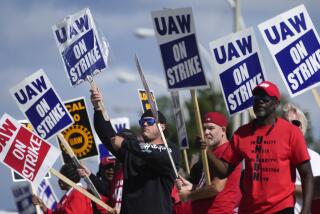New UAL Deal May Set the Pattern for ‘90s
- Share via
Questions come easily. Will United Airlines employees finally get to own the airline as a result of the proxy fight launched on Monday for UAL Corp., the airline’s parent company, by the investment firm Coniston Partners?
And if so, what does that mean for the employees? If some of United’s unions were willing to offer wages and work rule concessions last October in support of a $300-a-share offer to buy UAL--a bid that fell through for lack of financing--would employees be getting a bargain today? All the company unions are now backing an offer that would give shareholders $150 a share in cash, plus perhaps $40 more in notes and non-voting stock.
Also, what does it mean for the airline? After a takeover, would United become a debt-burdened company, losing out at home and abroad to better-financed competitors, such as American and Delta?
Finally, what does the UAL proxy contest say for companies and takeovers in the 1990s?
Answers come harder and are necessarily tentative. But on United, probably yes, the employees one way or another will get to own some major part of the airline. It is their backing that gives the Coniston bid credibility--and credibility is all important, says a New York arbitrage trader in takeover stocks.
If a bid looks as though it can succeed, company managements generally don’t let it come to a vote, says the arbitrager. “It’s like Russian Roulette, you lose and you’re out.” That’s why UAL management and directors are considering some action--in cooperation with employees--to recapitalize the company and boost the stock price.
In other words, one way or the other the three-year battle for control of United Airlines will be resolved in the next few months. And it would be a blessing for United if it could put takeover fights behind it and concentrate on global opportunities in the travel business.
Ever since last October, when a $300-a-share bid by UAL management, British Airways and United’s pilots and flight attendants--but not its machinists union--failed, United stock has been held by unhappy shareholders. The stock fell from $294 a share to just above $140 a share before Monday’s bid (it closed Tuesday at $152 a share). The Coniston group is still sitting with a loss of about $23 million on its holding of 11.8% of UAL stock.
If a deal can be done with as much as $150 in cash--plus notes and such--those unhappy shareholders won’t make a killing, but they’ll be able to get out with some cash in hand. And instead of impatient shareholders, the company would be owned in large part by its own people through employee stock ownership plans (ESOPs).
True enough, the costs of financing employee ownership would be heavy--$4 billion or more. But the ESOP form would help lighten them because it has tax advantages designed to encourage employee ownership. Thus, banks could offer lower interest rates because half the interest they collect on ESOP loans is tax deductible.
And the company can deduct loan principal for tax purposes, too. That plus the fact that United owns many of its airplanes--allowing collateral for lenders, or for sale-leaseback deals to lower total borrowing--makes the financing do-able, says analyst Daniel Hersh of Bateman Eichler, Hill Richards, a Los Angeles brokerage firm.
A leading international banker agrees in principle, saying that though debt markets are extremely cautious these days, a lower price for UAL and the fact that all the company’s unions are on board could well make a difference. “The right deal can be done,” says the banker.
Still, if United is not to be crippled by the burden of debt repayments, employees will have to earn their ownership by sacrifice. Through wage and work rule concessions, they will have to reduce United’s $3-billion-a-year labor costs by $300 million to $400 million annually. That means all employees will have to do more work for the same or lower pay and eliminate obstructive work rules--pilots would agree to fly two to a cockpit, for example, instead of insisting on rules requiring three.
What would they get for their sacrifice? They’d get ownership of the company through their ESOPs. Under the Coniston plan, UAL employees would own 75% of the company, and public shareholders would own the other 25% in the non-voting shares to be issued.
And quite possibly employees would get a bargain. Last year, analysts valued United’s assets at $240 to $260 a share and more. Those values really haven’t changed, even though the stock price has tumbled. Which means that United’s employees stand right now to buy more than $5 billion worth of company for $4 billion.
A bonanza? Not really. The value in United’s assets--like those of any going business--is potential, capable of being realized over time but not in a quick sale. A bust-up auction of UAL’s property and planes today might bring little more than $3 billion. But skillful operation of the airline can produce more than $500 million in income per year plus appreciation of the company’s value. And that’s why the UAL proxy contest could be a model for the ‘90s--because it might shift the emphasis back to hard-working, patient ownership.
If its employees keep United tops among world airlines, they can not only get rich but prove that the long term is a better bargain than the short.
More to Read
Inside the business of entertainment
The Wide Shot brings you news, analysis and insights on everything from streaming wars to production — and what it all means for the future.
You may occasionally receive promotional content from the Los Angeles Times.










